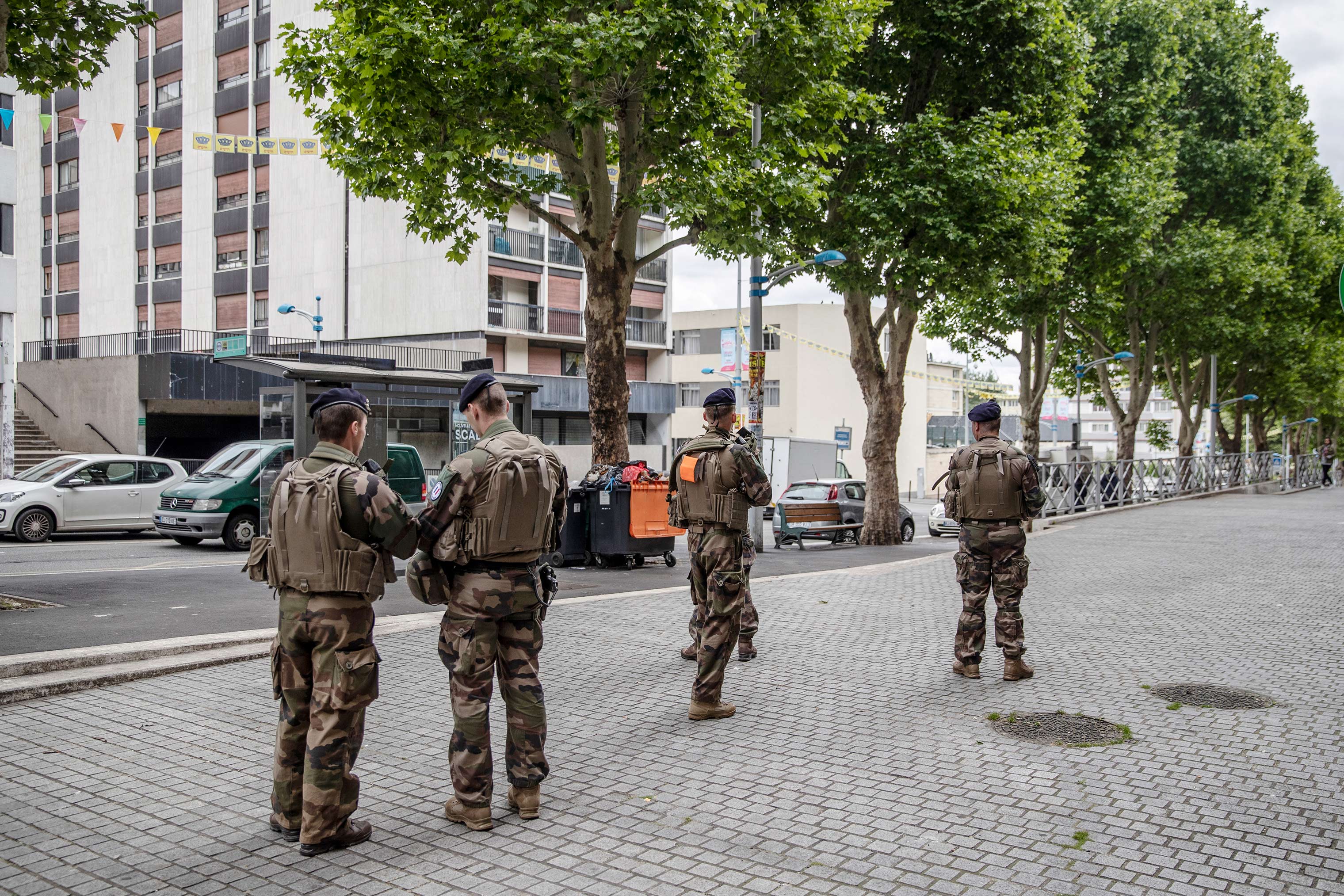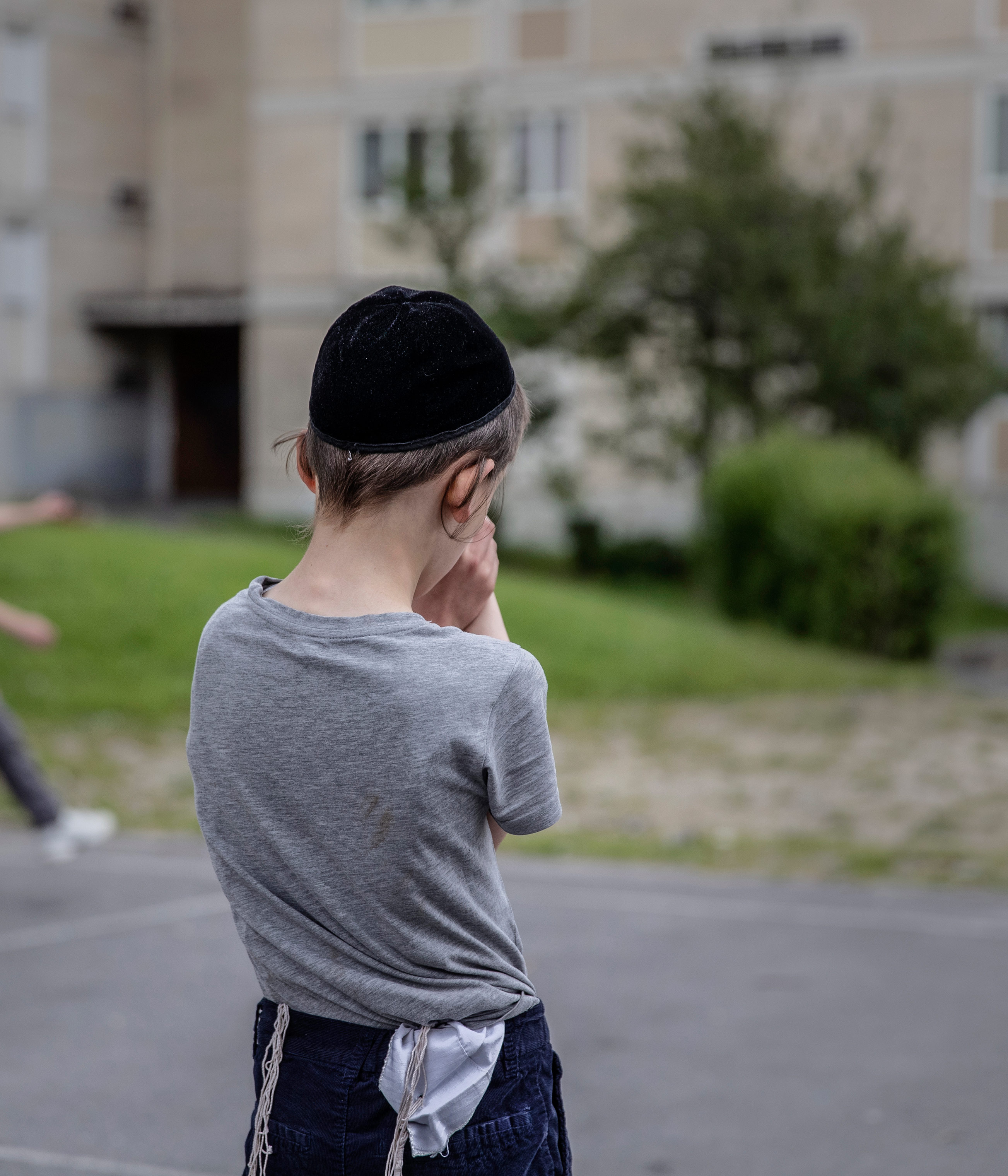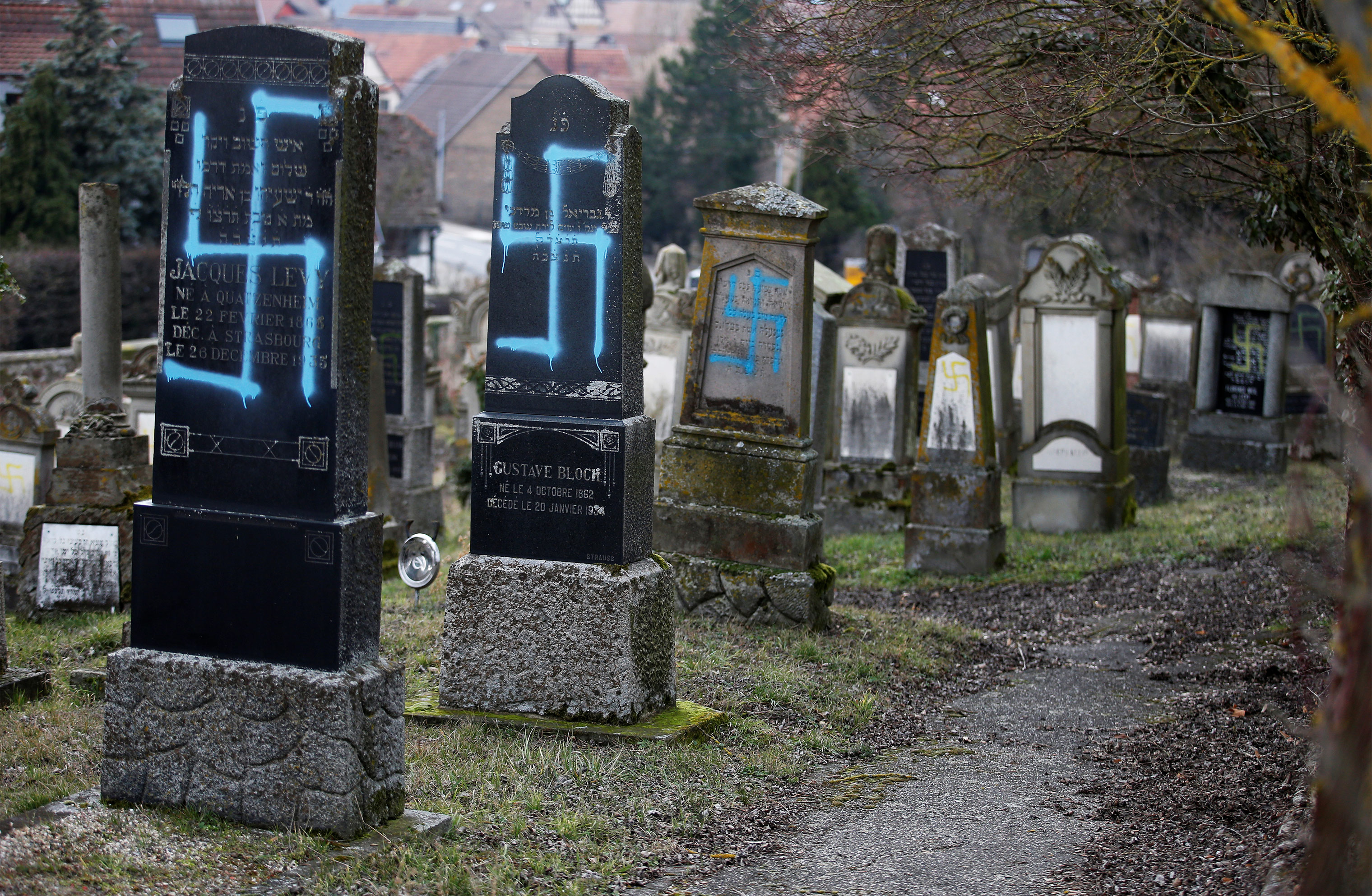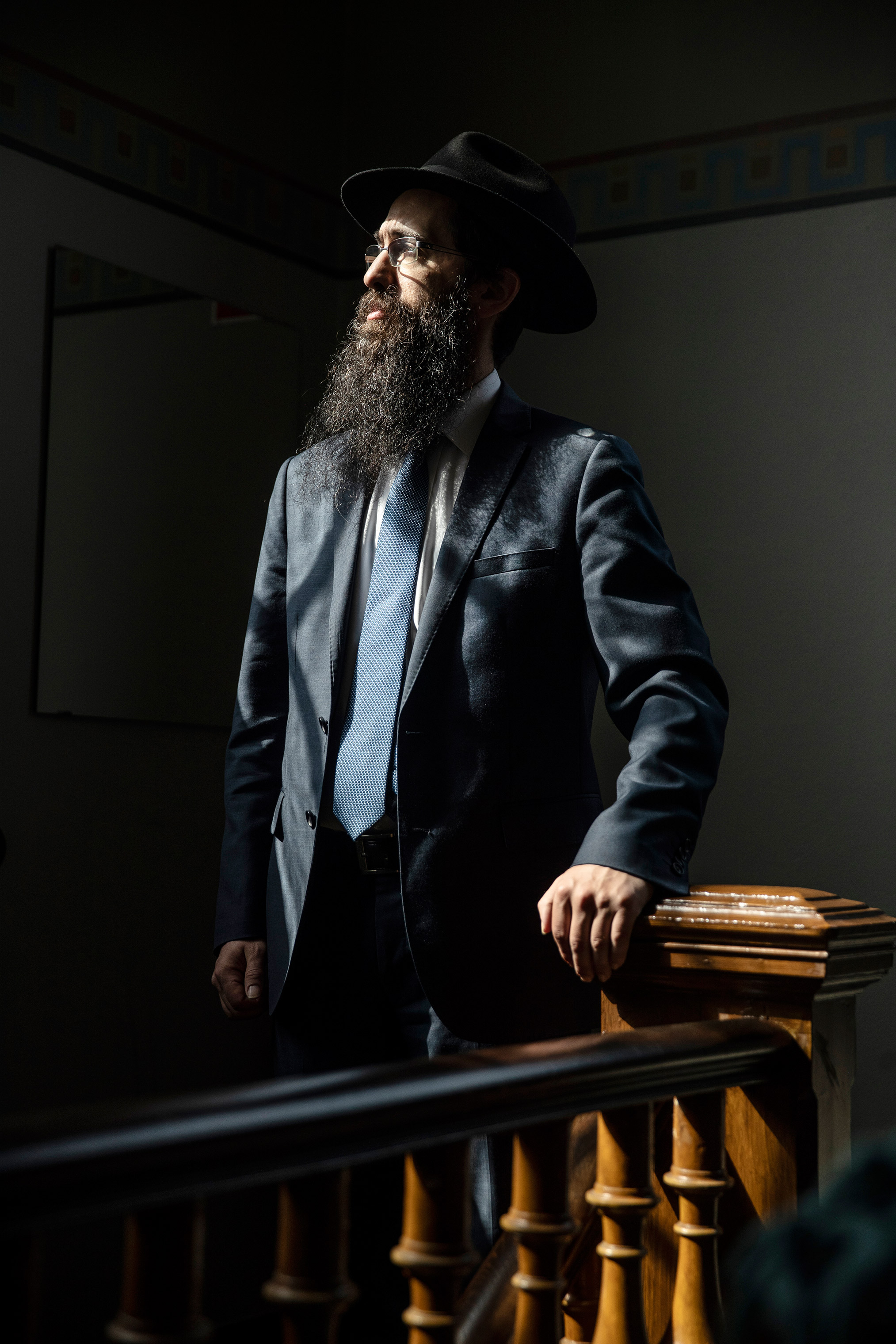The note jammed onto a windshield in Sweden in March last year was designed to terrify. WE ARE WATCHING YOU, YOU JEWISH SWINE, read the message to a retired professor, written on paper with the logo of the Nordic Resistance Movement, a Swedish neo-Nazi organization.
In the bucolic university town of Lund, with its cobblestone streets and medieval buildings, the threat seemed jarringly out of place. More notes followed. “I was really scared,” says the professor, a small woman of 70, who is too fearful about a further attack to reveal her name in print.
Finally in October, an attacker broke into the professor’s home before dawn and set it alight. By a stroke of luck, the professor was not there. But her living and dining rooms were reduced to ash. So too were the writings of her late mother, detailing her internment in the Nazi concentration camp of Auschwitz. “For the first time in my life I have needed therapy,” she says, over tea in a sunlit café in Lund. “I have not known what to do with my life.”

The professor was targeted because she is Jewish, and in that she is not alone. Anti-Semitism is flourishing worldwide. Attacks on Jews doubled in the U.S. from 2017 to 2018, according to the Anti-Defamation League (ADL) in New York City. That included the shooting in Pittsburgh’s Tree of Life synagogue last October, which killed 11 worshippers.
But the trend is especially pronounced in Europe, the continent where 75 years ago hatred of Jews led to their attempted extermination. The numbers speak plainly in country after country. For each of the past three years, the U.K. has reported the highest number of anti-Semitic incidents ever recorded. In France, with the world’s third biggest Jewish population, government records showed a 74% spike in anti-Semitic acts between 2017 and 2018. And in Germany, anti-Semitic incidents rose more than 19% last year. The findings prompted Germany’s first anti-Semitism commissioner to caution Jews in May about the dangers of wearing kippahs, the traditional skullcaps, in public.
Unsurprisingly, many Jews in Europe feel under assault. In an E.U. poll of European Jews across the Continent, published in January, a full 89% of those surveyed said anti-Semitism had significantly increased over five years. After polling 16,395 Jews in 12 E.U. countries, in a separate survey, the E.U.’s Fundamental Rights Agency concluded that Europe’s Jews were subjected to “a sustained stream of abuse.” With the decade drawing to a close, 38% of those surveyed said they were thinking about emigrating “because they no longer feel safe as Jews,” says the E.U. report.
European officials were stunned at the findings, but perhaps they ought not to have been. A complex web of factors have combined to create this moment in time for one of Europe’s oldest communities. Anti-Semitism has found oxygen among white supremacists on the far right and Israel bashers on the far left. Millions of new immigrants are settling in Europe, many from Muslim countries deeply hostile to Israel and sometimes also Jews. Exacerbated by the Internet’s ability to spread hatred, anti-Jewish feeling is surging in way that experts fear could result in a conflagration, if governments and communities fail effectively to tackle its causes.
And yet, for all the grim statistics, there are signs of hope across Europe. As anti-Semitism has risen, the fight against it has intensified, both among regular Europeans and their politicians. E.U. leaders now describe the battle as one they cannot afford to lose, as though it encapsulates the struggle for Europe’s very soul. “Anti-Semitism is a negation of what France is,” French President Emmanuel Macron said in February, after visiting a Jewish cemetery where swastikas had been daubed on some 80 graves.
Not waiting for their leaders, communities across Europe have begun to take action themselves. Raised learning about Nazism, many fear what might happen if anti-Semitism is left unchallenged. In recent years, teachers, imams, rabbis and local activists have launched countless initiatives to break stereotypes, educate youth and forge links across religions. In several interviews with TIME, those fighting anti-Semitism caution that it is likely to take many years for their efforts to succeed. Still, they have begun. In Paris, Delphine Horvilleur, a rabbi and author of a recent book on anti-Semitism, says a young Muslim worshipper approached her in her synagogue after she presided over a joint Muslim-Jewish prayer service.
“He told me, ‘I grew up in a family where anti-Semitism was the music in the background,’” she says. Now, she says, “We have to ask ourselves, How can we make sure they have the ability to lower the volume?”

The horrors of World War II shamed the world into acknowledging the evils of anti-Semitism. But exposure did not cure it. Instead, say experts, the hatred simmered for years. “There was a consensus that anti-Semitism should not be voiced openly after World War II,” says Günther Jikeli, a specialist in European anti-Semitism at Indiana University, who is German. “This has gone away with time.”
The growth of the Internet provided new platforms for conspiracy theorists to circulate racist fantasies more broadly. After the financial crisis of 2008, for example, the ADL warned that anti-Semites were spreading lies on message boards that Jews were somehow to blame for the crash. One rumor went that Lehman Brothers, the vaunted U.S. investment bank founded by Jewish immigrants from Europe, had transferred $400 billion to Israeli banks prior to its collapse.
A decade on, those who monitor anti-Semitism believe each attack or conspiracy theory posted online, no matter how small, sets off others. As social media has become an ever greater and yet more unregulated part of our lives, hatred has proliferated. “It used to be that anti-Semitism peaked during times of conflict in the Middle East,” says Katharina von Schnurbein, the European Commission’s first-ever coordinator for combatting anti-Semitism. “Now the incidents remain at their highest level ever recorded.”
Von Schnurbein was appointed in 2015 after three mass shootings in Europe put the problem of anti-Semitism in stark relief. Each was committed by Muslim extremists born and raised in Europe, claiming allegiance to al-Qaeda or ISIS. The first, at a Jewish school in Toulouse, France, in 2012, killed three children and a rabbi. Then in 2014, a gunman killed four people at the Jewish Museum in Brussels. In Paris the following year, four people were killed at a kosher supermarket in the French capital.
Jews were by no means the only victims of Islamist terrorists amid the rise of ISIS. European officials had long understated anti-Semitism among Muslim Europeans, perhaps for fear of feeding anti-immigrant sentiment. They finally appointed two coordinators in late 2015 to combat anti-Semitism and also anti-Muslim hatred—twin prejudices that seem to rise and fall in tandem. “They feed into one another,” says Marwan Muhammad, former director of the Collective Against Islamophobia in France. Just as discrimination against Muslims is a “daily experience” he says, so is anti-Semitism “more or less everywhere.”
Some claim anti-Semitism has become normalized in certain Muslim communities in France. “People receive the message of hatred of Jews from their babyhood,” says Rabbi Michel Serfaty, founder of the Jewish Muslim Friendship Association of France, which organizes joint social activities for Muslim and Jewish youth in a heavily immigrant area south of Paris. He says he recently tried to introduce some of the teenagers to classical music. “They laughed, saying, ‘That is for Jews.’ It is banned in their homes,” he says.

Tensions sporadically erupt in violence. In Sarcelles, a French commune where Jews and Arab immigrants have lived alongside each other for decades, violence erupted during a pro-Palestinian march in 2014. Jewish businesses came under attack by demonstrators, many of them Muslim. Five years on, the Jewish residents of Sarcelles live with armed French soldiers on permanent patrol on their streets, in a measure of the government’s concern about further race riots. “We live with a sense of anxiety,” says René Taïeb, a Jewish community leader, sitting in a kosher café in Sarcelles. “We have a bag packed, ready to go, in the closet.”
But Europe’s most hardcore anti-Semites are arguably on the far right, and they are slowly joining the mainstream, as Europe’s political loyalties have fractured and polarized. In Hungary, the far-right Prime Minister Viktor Orban’s campaign against Hungarian-American billionaire George Soros is regarded as thinly veiled anti-Semitism. And here in Sweden, ostensibly the most liberal country in Europe, a group of far-right extremists has achieved something close to political legitimacy.
The Nordic Resistance Movement may seem like a delusional fringe group; its toxic goal—to rid Sweden of Jews—has attracted just a few hundred active members around Scandinavia, according to estimates by the Expo Foundation in Stockholm, which tracks white supremacists. But in 2015, the Nordic Resistance Movement registered itself as an official political party in Sweden, perhaps offering it some political cover against an outright ban by the government.
The group won about 2,000 votes in legislative elections last year, and participated in the country’s annual gathering of political parties. But its tiny size is belied by its presence online, which hugely amplifies its message. “The reach of these ideas is become stronger because of the Internet,” says Jonathan Leman, researcher for the Expo Foundation. Leman says the group’s impact is reflected in the higher rate of anti-Semitic incidents reported by Swedish Jews, like bullying at schools and workplaces. “There is a connection between this propaganda and the experience of Jews,” he says.
On the opposite end of the political spectrum, anti-Semitism has also flared up. During months of the so-called Yellow Vest protests in France, a handful of demonstrators in the crowd resurrected the stereotype of Jews controlling the levers of power. In February, a group of protesters accosted renowned French philosopher Alain Finkielkraut on a Paris street, screaming, “You are going to hell!” and “Go back to Tel Aviv!”
The problem is not always so overt, however. In the U.K., the opposition Labour Party leader Jeremy Corbyn has faced fury among some members over his alleged tolerance for anti-Semitism, especially regarding criticism of the Israeli government. The veteran leftist has said the party’s problem stems from a “small number of members and supporters,” and has pledged to stamp it out. But his defense has rung hollow to some. “The party is institutionally anti-Semitic,” says Luciana Berger, a Jewish member of Parliament who quit Labour this year over the issue. Under Corbyn, she tells TIME, “there is more of a permission for it to happen now.”

The experience of Jewish people in Europe varies widely, but the stories are sometimes grim. In 2010, Carinne Sjoberg, an Israeli-born immigrant who has lived in Umea, Sweden, for 35 years, opened a Jewish community center, enabling the area’s 120 or so Jews to celebrate holidays like Passover and Rosh Hashanah together for the first time in the town’s history.
But one morning Sjoberg arrived at the center to find photos of Hitler pasted outside. These became a regular feature every January on Holocaust Memorial Day, along with swastikas painted on the walls. Then the messages turned personal. A notebook left at Sjoberg’s home listed “100 reasons you should leave Sweden.” After that came death threats. “I got messages on my phone saying, ‘We will kill you and your kids,’” says Sjoberg, 58, who is a local council member for Sweden’s Liberal Party.
After a stream of threats, Sjoberg finally shut the Jewish center in 2017, and last year she moved home, fearing an attack. Her new address and phone number are now kept secret. “Somewhere they broke me,” she says. “It was a journey of pain.”
Many Jews in Europe say it is not the major incidents but the minor ones that prove how widespread this problem is. They describe anti-Semitism as having seeped into quotidian life, in some ways complicating the effort to tackle the problem. “Unless it is very serious and you are physically attacked, there is a tendency not to call the police,” says Fredrik Sieradzki, spokesman for the Jewish community in Malmo, on Sweden’s southern border with Denmark.

Robert Ejnes, executive director of France’s major Jewish organization, CRIF, says that recently, his 18-year-old daughter almost forgot she had been called a “dirty shitty Jew” in the street near their Paris home. She mentioned it to her father much later, as an afterthought. “It was not the event of her day,” says Ejnes, shaking his head. “To me, that spoke to the depth of the problem.” In its 2018 database on anti-Semitism, the Kantor Center said the phenomenon “has mainstreamed and become an integral part of life.”
The more insidious effect is not at all visible: the choice by many Jews to remain discreet about their religious background. In numerous interviews, European Jews tell TIME that they avoid wearing a Star of David, and if they do, they tuck it under their shirts. Many also forgo affixing the traditional miniature prayer scrolls, called mezuzahs, to their doorposts, as many American Jews do, choosing instead to hang them inside. “Parents say to their kids, ‘Don’t tell your friends you are Jewish.’ Jewish teachers are afraid to tell kids they are Jewish,” says Shneur Kesselman, the Chabad-Lubavitch rabbi of Malmo, who moved from his native Detroit in 2004.
The community recently installed bulletproof glass on the window of the library in Malmo’s synagogue, which dates from 1903. Kesselman says Jews have steadily adapted to low-level hostility. “We feel so long as our names are not on a list, we are O.K.,” he says. “There is a danger that we are accepting much too much.”

Europe has begun to take action at an official level. Von Schnurbein, the European Commission coordinator, believes anti-Semitism has always signaled bigger violence ahead in Europe, as an early indicator of spiraling tensions. For that reason alone, she says, “we will do everything we can for Jews to have a future in Europe.” On June 20, the European Commission gathered together police and officials from interior ministries as well as Jewish community leaders to forge strategies for better security.
But increasingly communities are attempting themselves to heal the rift created by anti-Semitism, through outreach and education. Just one example is in Malmo, home to about 1,500 Jews, as well as about 45,000 Muslims. In 2017, Moshe David HaCohen, a rabbi originally from a Jewish settlement on the West Bank, joined forces with Salahuddin Barakat, one of the city’s imams, who is from Beirut. The two launched Amanah, an organization to fight both anti-Semitism and Islamophobia in the city.
The partnership of the two men — an odd couple from opposite sides of the Middle East conflict — has served as a powerful message in itself. In 2017, for example, a pro-Palestininian support group chanted “Death to the Jews” during a demonstration in Malmo, in response to President Donald Trump’s moving the U.S. embassy to Israel from Tel Aviv to Jerusalem. HaCohen and Barakat invited the group to meet the next day to discuss the region. “It really put our work to the test,” HaCohen says. The meeting ended with the demonstrators saying “every Jew must feel safe,” he says.
After two Muslim teenagers attempted to set fire to Malmo’s synagogue last March, HaCohen and Barakat telephoned their school principal, then visited the class the next day to discuss the incident. “We did not point out the kids,” Barakat says, explaining they used the time to give a lesson about anti-Semitism, rather than punish them.
Elsewhere in Malmo, Jewish communities have devised other tactics. Public hostility against Kesselman, Malmo’s Hasidic rabbi, inspired local psychologist Jehoshua Kaufman to organize a protest that was both a demonstration and a show of faith — a kippah walk, on which both Jewish and non-Jewish citizens wear the traditional skullcaps in public, in protest against anti-Semitism.

One evening in 2011, Kaufman says, he asked about 15 congregants in Malmo’s synagogue to join him in not removing their kippahs as they left the building. “The community said, ‘They will kill us in the streets,’” he recalls. “They said, ‘You need police protection.’ I said no police.” The walk proceeded peacefully, and Kaufman says the experience was liberating. “Within a few weeks there were 100 people walking,” he says. “Then suddenly it was 500 people, and politicians showed up to make speeches.” There are now regular kippah walks in Malmo, Stockholm and Berlin.
Taïeb, the community leader in Sarcelles, says the best form of resistance might be to remind anti-Semites who Jews really are — their neighbors, and fellow citizens. He recalls watching the protest in 2014 spiral into violence and deciding to gather about 100 men to surround the synagogue. Instead of chanting Jewish prayers, as one might have expected, they decided instead to sing “La Marseillaise,” France’s national anthem. “We wanted to make the point that we are French, really French, who happen to be Jewish.”
Few believe there is a quick solution to -Europe’s problem of anti-Semitism, however. In Lund, the culprit behind the arson attack on the Jewish professor’s house has not yet been identified. A separate attack, also in October, likewise remains unsolved. Police remain uncertain whether the Nordic Resistance Movement, or someone inspired by it, committed the attack. “We are always afraid of the lone wolves,” says Zandra Brodd, chief police inspector for hate crimes in southern Sweden. That worry has increased, she says. “The language on social media is hardening.”
Yet, after a long period of feeling paralyzed by fear, the professor says she is finally venturing out. “Every day, I wake up and tell myself to go out and repair myself,” she says. Her home, rebuilt, now has security glass and alarms, far different from before the attack. “My house was wonderful, totally open, with big magnolia trees in the garden. The magnolia trees survived.” —With reporting by Suyin Haynes/London
Correction: The original version of this story included a photo caption that misstated the role of Rabbi Shneur Kesselman. He is no longer rabbi of the main synagogue. The story also misstated how and where bulletproof glass had been installed in Malmo’s synagogue. It was installed by the community, not by Kesselman, and the window was in the library, not in Kesselman’s office.
- Donald Trump Is TIME's 2024 Person of the Year
- Why We Chose Trump as Person of the Year
- Is Intermittent Fasting Good or Bad for You?
- The 100 Must-Read Books of 2024
- The 20 Best Christmas TV Episodes
- Column: If Optimism Feels Ridiculous Now, Try Hope
- The Future of Climate Action Is Trade Policy
- Merle Bombardieri Is Helping People Make the Baby Decision
